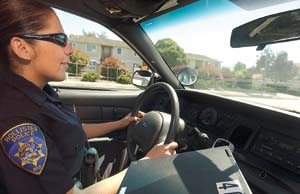Huge overtime bills, safety issues and sergeants relegated to
patrol are just a few of the problems the Hollister Police
Department is facing because five officers are on the injured list,
according to Police Chief Jeff Miller.
Huge overtime bills, safety issues and sergeants relegated to patrol are just a few of the problems the Hollister Police Department is facing because five officers are on the injured list, according to Police Chief Jeff Miller.
The police department is struggling to keep the minimum amount of officers on the street and is paying overtime to do so.
With 32 sworn officers on staff, including Miller and two captains, the injuries of three officers and two sergeants creates major safety issues for officers and residents, Miller said.
“First and foremost there’s officer safety – whether or not we’ll have enough people to back up officers,” Miller said. “Then there’s community safety – if there’s enough officers to respond to calls in a timely manner.”
The department, which will suffer the loss of six positions because of the city’s projected $4 million deficit, started the 2003-2004 fiscal year with an overtime budget almost 50 percent lower than the previous year, Miller said. The department’s overtime budget was decreased from almost $300,000 to about $159,000, Miller said.
Injured officers put added pressure on the already depleted budget, he said.
“It has a huge effect on overtime,” he said. “I don’t have the most recent numbers, but we’ve probably exceeded it by 100 percent.”
The amount of overtime varies between departments (within the police department) and shifts, Miller said. The department does not have overtime statistics broken down for individual officers, but is working with the City of Hollister Finance Department to better analyze it, he said.
“The system will code different hours of overtime so we can see how much money we’re spending on injured officer replacement, special duties such as parades, and so on,” Miller said.
Between the staffing cuts and injuries, a total of 16 healthy officers and five sergeants are available for patrol, down from about 18 when the department is at full capacity. But to maintain that level on patrol, the department has to pull officers off other duties. Because the number of officers on patrol has to be steady, sergeants that previously worked inside the department, such as a training sergeant and personnel and community service sergeant, have been put back on the street, Miller said.
An officer has taken on the duties of the personnel and community service sergeant because it plays a critical role in keeping officers up to date with training standards, certification and other important internal work, he said.
Training programs including driving and defensive tactics classes, and several community-based programs such as the Police Explorers and Volunteers in Policing (VIPs), have been sidelined since Training Sgt. Ray Wood was put back on patrol.
“I’m hoping somebody else picks up the ball, but I don’t know if that’s going to happen,” Wood said.
Two of the individuals have been out on injury or on light-duty since before Miller joined the department nine months ago, he said.
The most recent addition to the list was injured last week. A couple of the injured officers should be back on patrol within a few weeks. Miller could not elaborate to the types of injuries or which officers were injured for personnel reasons, he said.
All five officers injured were hurt on the job, said Capt. Bob Brooks. That makes them eligible for worker’s compensation with full pay and benefits, he said.
The number of officers on patrol varies by shift and time of day, Brooks said.
In an average 24-hour period, about nine officers and three sergeants patrol the streets. Those numbers are increased on Friday and Saturday nights between 9:30 p.m. and 1:30 a.m., which are “peak hours,” Brooks said.
The swing shift, the 3:30 p.m. to 1:30 a.m. shift, overlaps with both the day and graveyard shifts because calls are usually the heaviest during those hours, Brooks said.
“We try not to go below one sergeant and three officers. If someone’s sick or on vacation or hurt we’ll call people in for overtime,” Brooks said. “We want to have enough officers to safely respond.”
The loss of able bodies puts the department in a tough spot, making it that imperative the numbers are carefully scrutinized and basic services are being provided, said Mayor Tony Bruscia.
“When five officers are injured in a department our size that’s a lot,” Bruscia said. “Something needs to be figured out.”
Conducting more training sessions or implementing an incentive program are two ways the department could cease adding names to its injured list, Bruscia said.
“I’ve done (incentive programs) for businesses before – they motivate employees to work safer and have less injuries,” Bruscia said. “It has a dramatic effect sometimes.”
Besides accruing substantial overtime, injuries affect the physical and mental well-being of healthy officers, Miller said.
“The burnout rate, when officers can’t get time off to rest and recuperate because they’re constantly working, makes them more prone to mistakes and injury,” Miller said. “It starts a very vicious cycle… that leads to more overtime and more fatigue.”










